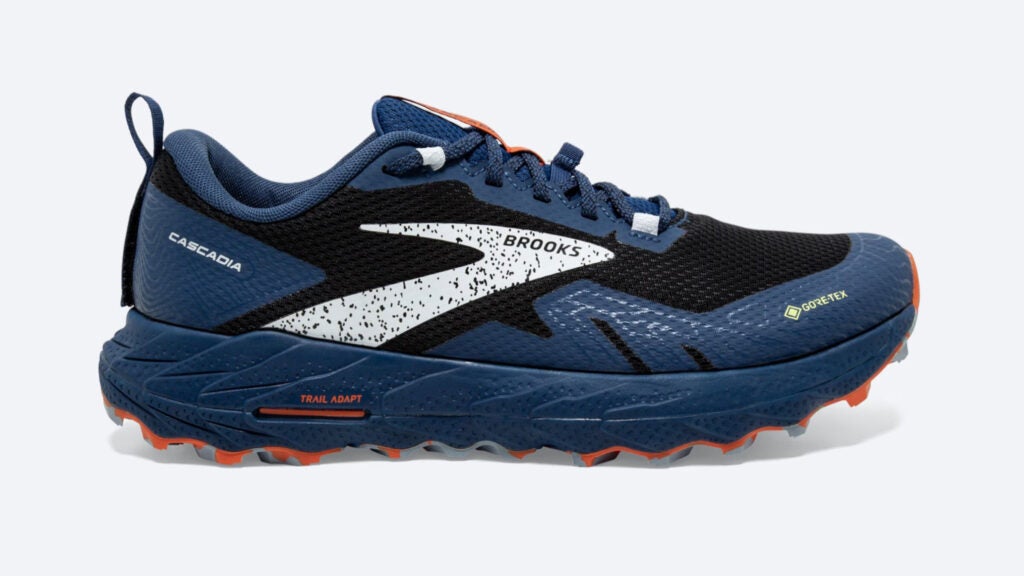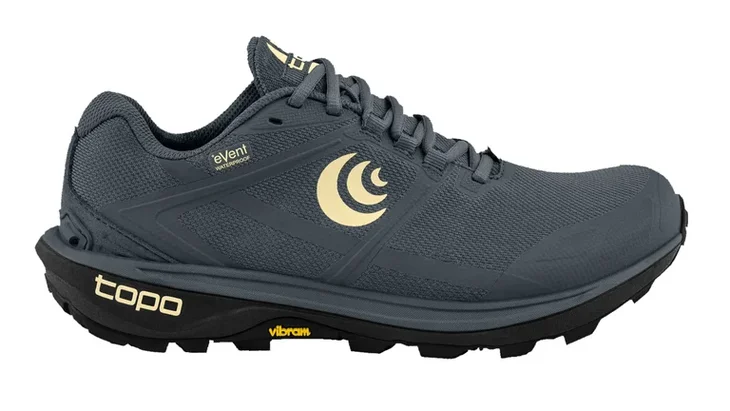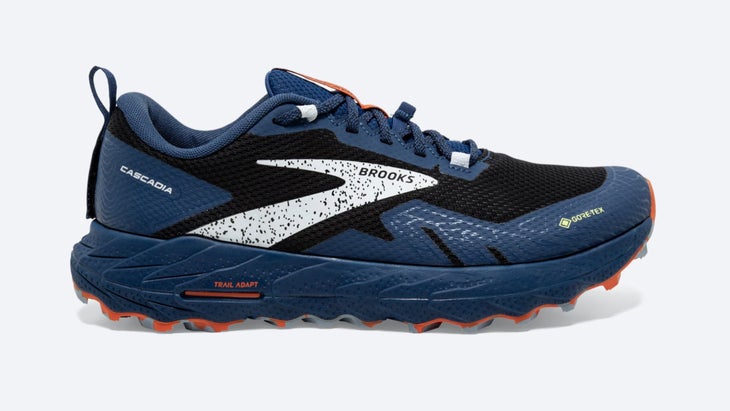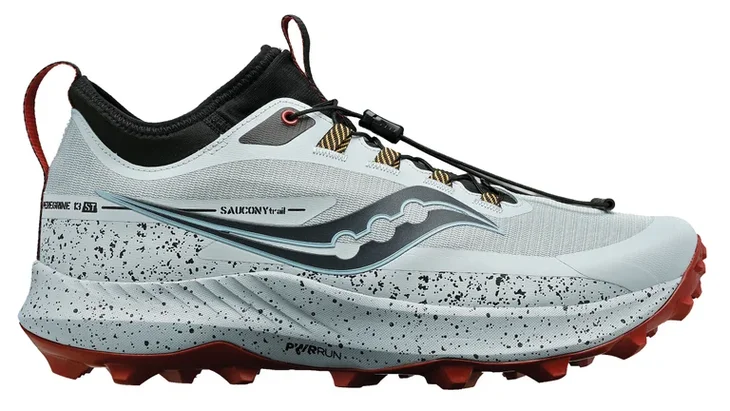



Making the switch from a mid- or high-top hiking boot to a low-cut, low-weight trail running shoe is a big step, and one even many casual hikers are making these days. But once you’ve done it, it can be hard to imagine going back. That can occasionally make things tricky in the colder months of the year, when low temps, unpredictable conditions, and the possibility of snow puts lightweight footwear to the test. If you’re determined to rock your trail runners year-round, it helps to buy them with that in mind.
We polled three of our favorite footwear gurus—Backpacker gear editor Ben Tepler, Trail Runner editor-in-chief Zoë Rom, and Outside senior running editor Jonathan Beverly—and asked them for their advice on the best-performing trail runners for shrugging off gnarly late-season conditions on overnight trips and day hikes in the backcountry. From ultralight stalwarts to tough, precip-proof shoes, these were five of their top picks.
Looking for more shoes? Find four of these and more on Outside’s list of The Best Trail Running Shoes of Winter 2024

Weight: 12 oz (men), 10.1 oz (women)
Stack Height: 25–22mm
Drop: 3mm
Sizing: Men’s 7–15, Women’s 6–12
Sloppy winter hikes call for shoes capable of keeping you dry from the outside in. These trail runners marry the waterproofing, stability, and protection that we’ve come to expect from low-top hikers with the low weight and agility of a legit running shoe. A waterproof eVent upper shrugs off slush, while a low-profile, toothy outsole and flexible rock plate in the midfoot eliminates sore spots on even rocky terrain. The snug-in-the-heel, roomy-in-the-toe-box design is comfortable for long miles while reducing movement and rubbing: As one tester told our reviewer in this year’s Winter Gear Guide, “this shoe fit my foot like a glove.” With a heel-toe drop of just 3 millimeters, the Terraventure 4 is a solid choice for anyone who’s interested in exploring lower-drop shoes but not ready to commit to a zero-drop model. Buy Now (Men’s / Women’s)

Weight: 10.5 oz (men’s), 9.5 oz (women’s)
Stack Height: 29–22mm
Drop: 7 mm
Sizes: 6–14.5 (men’s), 5.5–11 (women’s)
If you appreciate the convenience of being able to quickly adjust your shoes one-handed, the Jackal II, a rugged shoe that’s ready to tackle the trickiest terrain, is a solid pick. Unlike many BOA-equipped trail runners, the Jackal II has two dials—one for the midfoot and one for the forefoot—allowing users to quickly customize their fit while barely breaking stride. In our tests, sticky rubber lugs and a TPU toe bumper ate up the trickiest mountain terrain. Also, a built-in gaiter kept gravel, graupel, and everything in between from sliding down the cuff. Buy Now (Men’s / Women’s)

Weight: 11.7 oz (men’s), 10.2 oz (women’s)
Stack Height: 33–24mm
Drop: 8 mm
Sizes: 7–14 (men’s), 6–12 (women’s)
If your tick list for the winter is full of rough and tough trails, the Cascadia 17 is up to the task. Thanks to a stiffer, stability-first design and grippy, chevron-shaped lugs through the fore- and midfoot, this heavy-duty runner is built to shake off hits from rocks and roots while still biting into a variety of surfaces. “It delivers a stable ride on rough terrain while maintaining an agile feel, and its rugged upper protects and holds up to gnarly trails,” Beverly says. A Gore-Tex Invisible Fit membrane stops errant splashes or melting snow from freezing socks. Buy Now (Men’s / Women’s)

Weight: 9.7 oz (men’s), 8.5 oz (women’s)
Stack Height: 30–26mm
Drop: 4 mm
Sizes: 7–12 (men’s), 5–12 (women’s)
If there’s one constant about late-fall and early-winter hiking, it’s the constantly changing trail conditions: Over the course of one weekend trip, you could find yourself tromping through snow, then slogging through mud as warming temperatures melt it away. The Peregrine 13 ST is a shoe specially made for those slippery-soft surfaces, with 6.5-millimeter-deep lugs and a relatively high stack height to keep you from wallowing. A built-in ankle gaiter (though shorter than the Cascadia’s) helps keep slop from sneaking in, while a quick-pull lacing system lets you adjust your fit to match the conditions. Buy Now (Men’s / Women’s)

Weight: 11 oz (men’s), 9.2 oz (women’s)
Stack Height: 25 mm
Drop: 0 mm
Sizes: 7–16 (men’s), 5.5–12 (women’s)
Is it cheating to put one of the most popular year-round trail runners for hikers on a list like this? Maybe, but our experts agreed that Altra’s popular Lone Peak is as good a pick in winter as it is in the warmer months. (Assuming that it’s relatively dry, that is: While the Lone Peak breathes well, the tradeoff is that it quickly lets water in. Ask us how we know.) The latest update to this old favorite features a more densely-spaced lug pattern that our testers said enhanced grip, as well as a more durable upper and a no-stitch bumper that irritated our testers’ toes less on long efforts. Buy Now (Men’s / Women’s)
Choose your waterproofing carefully. Don’t be fooled by the “breathable” in waterproof-breathable: The better your shoes resist moisture entry from the outside, the less capable they’re going to be of venting your sweat. While non-waterproofed models are our usual pick for most of the year, the possibility of having to wade through snow or slush—and the difficulty of drying out in cold temperatures—usually swings our calculus more toward Gore-Tex and other waterproofed versions in winter.
Choose your socks carefully, too. For winter hikes, we usually gravitate toward a mid-weight wool sock like the classic Darn Tough Hiker Micro Crew Midweight, which boasts a snug but comfortable fit, insulates well even in frosty temperatures, and will last you through years of abuse. Pro tip: Your feet will occasionally end up damp despite your best efforts, so pack an extra pair.
Shop for your shoes in person. Unless you already know exactly what you want and exactly how it fits, you’re best off going into a local brick-and-mortar store and trying on several different pairs. Don’t just put them on: Walk around the store, try standing on an incline, and imagine how your feet will feel after hours in them. Bonus: Outdoor store salespeople are often a good source of beta on how different shoes perform on your local trails. (Determined to shop online? Pick a site with a generous return policy, and try them on at home before you take the tags off.)
Know when to quit. For all our determination, there’s a limit to what trail runners can handle. Expect to be postholing or braving truly Arctic temperatures? You’ll be better off with a solid boot.
From 2023

